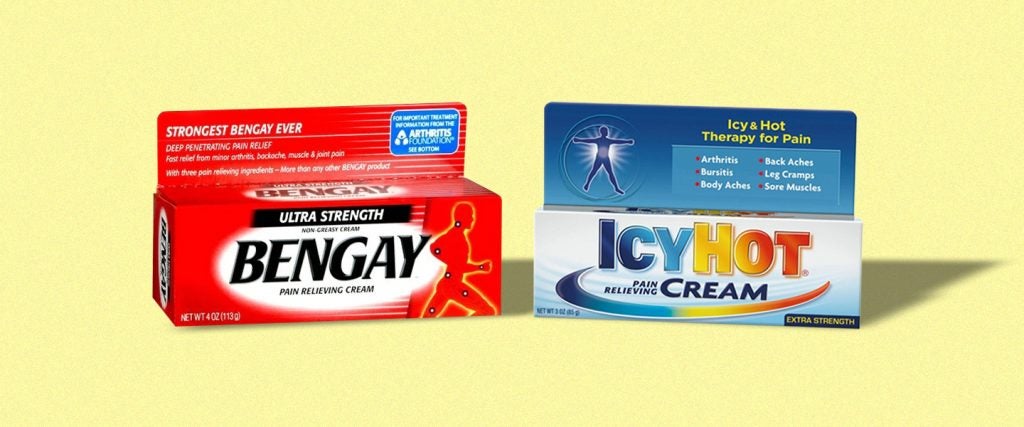With all due respect to Shaquille O’Neal, it’s hard to take the big man’s word for it when it comes to accepting his statement that IcyHot is his go-to topical pain reliever. After all, “The Big Endorsement” makes a reported $22 million a year from a series of such deals that include both IcyHot and Gold Bond Medicated Foot Powder. While Shaq is well within his rights not to fake the funk on a nasty foot fungus, it isn’t quite as innocuous as it appears when you recognize that Gold Bond also manufactures a set of medicated pain-relief ointments that tiptoe around the fringes of direct competition with IcyHot.
Either way, O’Neal’s endorsement has helped IcyHot ascend to the level of being the world’s best-selling topical pain reliever. Admittedly, though, sales volume can be attributable to myriad factors, including distribution range and price, so we can’t pin all the credit for IcyHot’s preeminence on Shaq’s meaty shoulders.
Speaking of meaty shoulders — particularly sore meaty shoulders — how does IcyHot stack up against its rivals? For instance, is it objectively better than a rival product like Bengay?
I’ve never even considered what’s at work within those topical pain relievers!
Well, you ought to. After all, you’re certainly not rubbing it on to improve the physical appearance of your skin.
First, let’s take a look at IcyHot’s standard cream. Its active ingredients are 10 percent menthol and 30 percent methyl salicylate. Interestingly enough, these chemicals are the respective active ingredients of peppermint oil and wintergreen oil, which means that you’re experiencing the combined benefits of more homeopathic remedies like the administration of the essential oil versions of the two products simply by slathering on some IcyHot. Both menthol and methyl salicylate have proven pain-relieving qualities, and both are known as counterirritants, which means they cause inflammation in one area — specifically the skin — in order to relieve pain in the muscles below.
When we step over to take a closer look at Bengay, we see that Bengay also has 10 percent menthol and 30 percent salicylate solutions, which suggests that it has the exact same active ingredients as IcyHot in the precise same concentrations. However, Bengay also contains a 4 percent camphor solution, or the active pain-relieving ingredient in cinnamon oil for those of you still keeping score on the essential oils front.
The ironic element to the inclusion of camphor in Bengay is inherent in the description of the sensations it induces. Specifically, camphor is known to cause cold and warm sensations in the skin when it’s applied. In other words, these Bengay-induced sensations could alternatively be described as “icy” and “hot.”
Are you saying that Bengay is better than IcyHot?
Not at all, but I am suggesting that a cursory look at the active ingredients in both would suggest that Bengay may have something different — if not something more — to offer, while similarly stimulating the skin of the affected area. Inactive ingredients do make a difference, so we certainly can’t downplay their role. After all, it’s the inactive ingredients that may cause you to prefer one type of energy drink over another that’s of a similar strength of stimulus. However, in terms of your body’s response to the applied analgesic rub, Bengay seems to have more ingredients that are acceptably fighting to alleviate your pain than IcyHot does.
Sold! I’m about to head off to CVS to score some Bengay!
Slow down, pal. We’ve got something else to discuss.
There’s another substance that reliably goes on icy and numbs the skin as it treats an area of the body that’s experiencing pain, and that’s ice. Ice has also been proven to expedite some healing processes in compromised areas of the body. As my favorite physical therapist Heather Asti once advised me, it’s far better to apply something to the area that improves the physical condition of whatever is causing the pain as opposed to masking the pain and leaving the affected areas unaddressed.
If you’re interested in selecting between IcyHot and Bengay, there is enough of a distinction to be made between them to select one over the other, but if you’re willing to exert a little more effort toward your self-care, the application of ice to the same area is likely to be more beneficial in most cases, and it will certainly be less expensive.
Benjamin Franklin famously said that an ounce of prevention is worth a pound of cure. Well, as far as holistic benefits to the body are concerned, it appears that an ounce of frozen water is worth a pound of pain cream.

